Colin Clive
Mae Clarke
John Boles
Boris Karloff
Edward Van Sloan
Frederick Kerr
Dwight Frye
Lionel Belmore
Marilyn Harris
Henry Frankenstein
Elizabeth
Victor Moritz
The Monster
Dr. Waldman
Baron Frankenstein
Fritz
The Burgomaster
Little Maria

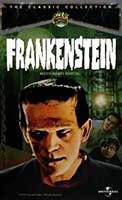
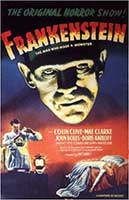
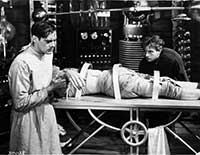 Frankenstein, based upon the novel by Mary Shelley, still has the power to frighten audiences today. Dr. Henry Frankenstein (Clive) is obsessed with the scientific problem of Life and Death. Taking life is easy. Creating life from lifeless tissue is another question. As future generations of film-makers will attest to, (ala Jurassic Park), Dr. Frankenstein continued with his mad quest without answering the fundamental question, “Should he?”
Frankenstein, based upon the novel by Mary Shelley, still has the power to frighten audiences today. Dr. Henry Frankenstein (Clive) is obsessed with the scientific problem of Life and Death. Taking life is easy. Creating life from lifeless tissue is another question. As future generations of film-makers will attest to, (ala Jurassic Park), Dr. Frankenstein continued with his mad quest without answering the fundamental question, “Should he?”
Dr. Frankenstein has spent many years on his experiments. He has crossed every “t” and dotted all the “i's”. He is ready to take his experiments to their conclusion: creating a Man from pieces and parts from various bodies. His grand scheme is to create a being entirely from scratch and bestow life upon it. He doesn't care where he gets his bodies, whether they are stolen from graves, cut down from the gallows or from laboratories.
But, Life will find a way: a way to mess up the carefully laid plans of mice and men. An accident by Frankenstein's assistant Fritz (Frye) leads to Frankenstein implanting a criminal brain into his creation. Oh well, you can't have everything.
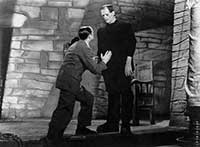 Meanwhile, Henry Frankenstein's fiance Elizabeth (Clarke) is worried about Henry. She hasn't seen him in weeks. The last message he sent her is more cryptic than explanatory. Actually, the letter is the furthest thing from a love letter as one can get, thus amplifying Elizabeth's concerns and her growing fear of Henry's physical and mental well being.
Meanwhile, Henry Frankenstein's fiance Elizabeth (Clarke) is worried about Henry. She hasn't seen him in weeks. The last message he sent her is more cryptic than explanatory. Actually, the letter is the furthest thing from a love letter as one can get, thus amplifying Elizabeth's concerns and her growing fear of Henry's physical and mental well being.
Elizabeth enlists the help of a dear family friend Victor (Boles) and Frankenstein's former mentor Dr. Waldman (Van Sloane) to seek out Henry and make sure he is O.K. Timing is everything and the trio arrives at the most inopportune moment for Frankenstein. He is making the final preparations as a storm builds in the mountains. Blast and Dadgummit!!!
Frankenstein relents and lets the trio into his laboratory for the finale to his experiment. He is successful bringing life to his creation. In his elation, he laughs maniacally and screams the blasphemous words, “Now I know what it it like to be God!” Frankenstein has the power to create life. However, he does not possess God's power to control life. Disaster soon follows.
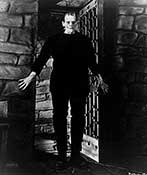 Director James Whale has crafted an eerie tale that is aided by the black-and-white film stock of his time. His camera techniques, lighting and scenery stand the test of time. He has crafted an ageless classic. The laboratory sequence is fantastic. The lab is filled with surgical and electrical equipment that spews out sparks making any sane person fear to be electrocuted. Frankenstein is too immersed in his work to notice.
Director James Whale has crafted an eerie tale that is aided by the black-and-white film stock of his time. His camera techniques, lighting and scenery stand the test of time. He has crafted an ageless classic. The laboratory sequence is fantastic. The lab is filled with surgical and electrical equipment that spews out sparks making any sane person fear to be electrocuted. Frankenstein is too immersed in his work to notice.
Colin Clive as Henry Frankenstein is an excellent choice. He has the range to be logical and sane one moment and then bordering on insanity and despair the next. Clive takes all of the joy and happiness out of Henry. Mad obsession is all that remains. He must finish his work, throwing all caution to the wind out the window. Only too late does he discover the massive error in his experiment. He has created a monster with extraordinary strength who cannot be destroyed by any normal means.
Not to demean the acting of Edward Van Sloan and Dwight Frye, these two actors propel the story by basically playing the characters that they will continue to play in similar Universal Pictures horror films. Van Sloane is the logical teacher with a thirst for knowledge yet he knows there are limits to Man's achievements.
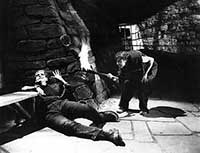 Frye is wonderfully creepy as Fritz, the precursor to Igor in later Frankenstein films. In one scene, Fritz torments the creature with a whip and torch. Stephen Sommers would later exploit this sequence in his film Van Helsing by having Igor speak the immortal words when asked why he treats the creature so cruelly, “That is what I do.” As the hunch-backed assistant Fritz, Frye plays him as a person who has been bullied his entire life and now has someone to take out his revenge on. Be careful if your dreams come true. God has a way of pulling the rug out from under your feet.
Frye is wonderfully creepy as Fritz, the precursor to Igor in later Frankenstein films. In one scene, Fritz torments the creature with a whip and torch. Stephen Sommers would later exploit this sequence in his film Van Helsing by having Igor speak the immortal words when asked why he treats the creature so cruelly, “That is what I do.” As the hunch-backed assistant Fritz, Frye plays him as a person who has been bullied his entire life and now has someone to take out his revenge on. Be careful if your dreams come true. God has a way of pulling the rug out from under your feet.
The creature/monster (Boris Karloff) makes his appearance on screen in horrific fashion. The creature walks into the laboratory backwards and slowly turns to reveal his gruesome features. Whale quick cuts to closer and closer shots of the creature's face. This often duplicated technique may seem silly or overdone by today's standards but this quick sequence must have terrified audiences.
In 1931, there were limited special effects. The horror had to be created through lighting techniques and fantastic makeup work. Karloff is fantastic portraying the creature in a horrific yet sympathetic tone. The creature is brought to life as an adult yet possesses none of the joys and pains of growing up. Karloff plays the creature as a child in a hulk's body who is quick to intense rage at the drop of a hat.
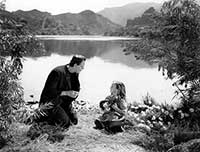 The most famous scene in Frankenstein happens when the creature comes upon a small child Maria (Marilyn Harris). Maria has been left alone by her father. She is outside playing with her kitten when the creature crashes through the bushes. Being an innocent child, Maria is not afraid of the creature. She isn't bothered by his garish look.
The most famous scene in Frankenstein happens when the creature comes upon a small child Maria (Marilyn Harris). Maria has been left alone by her father. She is outside playing with her kitten when the creature crashes through the bushes. Being an innocent child, Maria is not afraid of the creature. She isn't bothered by his garish look.
The two begin throwing flowers into the lake making boats. When the flowers run out, the creature picks up the girl and throws her into the water thinking that she will float like the flowers. Whale shoots the sequence from behind Karloff. All the audience can see is splashing water and the creature desperately trying to save the girl.
Karloff's acting in this sequence is amazing. He is able to portray several emotions simultaneously while not speaking. He groans, wails, screams while desperately flailing his arms trying to find help to save the girl. The creature knows full well that he has committed murder. There is no joy in this act. But there is regret, terror, frustration, helplessness, futility, despair, anger at his helplessness and finally blind rage! Karloff's acting is frightening.
Similar to the classic King Kong, the audience begins to sympathize with the creature after this scene. After finding the dead girl, the villagers are out for blood. They organize into a rioting mass that will pounce on the nearest stranger without asking questions first.
The finale to Frankenstein is predictable. But the predictability is based on the nature of the story rather than the audience seeing this before. The creature/monster must be destroyed. It is a living blasphemy with no redeeming qualities. This is not exactly accurate but no one has the skill or the temperament to educate the creature. He has already committed murder without knowing what murder was prior to committing the crime. No one has to tell the creature that he has committed a grievous crime, a sin against humanity and God's commandments. He knows.
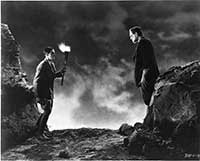 Dr. Henry Frankenstein must pay a price for his blasphemy. In a bit of poetic justice, the creature destroys his creator, very much like what Frankenstein did to his creator.
Dr. Henry Frankenstein must pay a price for his blasphemy. In a bit of poetic justice, the creature destroys his creator, very much like what Frankenstein did to his creator.
In what may be the first time in motion picture history, the technique of not quite ending the movie is used here. After being thrown off of a windmill, the audience is not certain that Dr. Frankenstein is dead. The creature is never shown actually dieing. Can anyone say sequel? Was the word “sequel” even in Webster's Dictionary in 1931?
After 75 years, Frankenstein still has the power and energy to scare audiences today. Kudos to Turner Classic Movies (TCM) for bringing this film back to the big screen. James Whale's film is riveting, quickly paced and still amazing for the set pieces, makeup work and the many layered portrayal of the creature by the great Boris Karloff.
Movie review © Larry Novotny/Spectre Films Ltd. All Rights Reserved.
All images © 1931 Universal Pictures